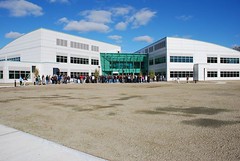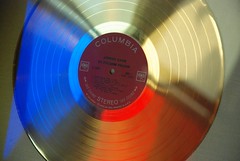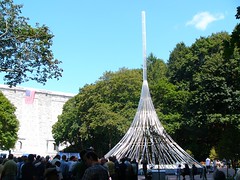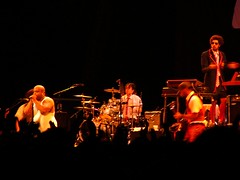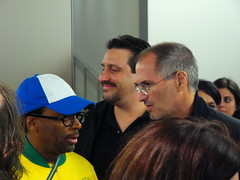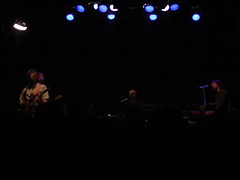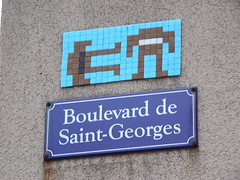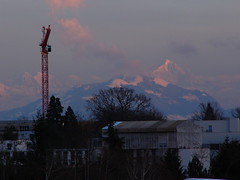 I can't imagine how many times I've told myself to keep a cleaner desk, although I've always prided myself on knowing basically where to find everything I need, even in the midst of overflowing piles. Thus, I've always suspected that it was the sign that I was productive and keeping busy. But now now that I've changed offices, as part of an overall move from Chemistry into the BNL Physics Department, I'm worried that my desk (and office) is cleaner than ever, since I haven't had enough time to really get it messy. Thus, this piece in the times today seems particularly relevant -- Back to work.
I can't imagine how many times I've told myself to keep a cleaner desk, although I've always prided myself on knowing basically where to find everything I need, even in the midst of overflowing piles. Thus, I've always suspected that it was the sign that I was productive and keeping busy. But now now that I've changed offices, as part of an overall move from Chemistry into the BNL Physics Department, I'm worried that my desk (and office) is cleaner than ever, since I haven't had enough time to really get it messy. Thus, this piece in the times today seems particularly relevant -- Back to work.
Thursday, December 21, 2006
Order in Disorder
 I can't imagine how many times I've told myself to keep a cleaner desk, although I've always prided myself on knowing basically where to find everything I need, even in the midst of overflowing piles. Thus, I've always suspected that it was the sign that I was productive and keeping busy. But now now that I've changed offices, as part of an overall move from Chemistry into the BNL Physics Department, I'm worried that my desk (and office) is cleaner than ever, since I haven't had enough time to really get it messy. Thus, this piece in the times today seems particularly relevant -- Back to work.
I can't imagine how many times I've told myself to keep a cleaner desk, although I've always prided myself on knowing basically where to find everything I need, even in the midst of overflowing piles. Thus, I've always suspected that it was the sign that I was productive and keeping busy. But now now that I've changed offices, as part of an overall move from Chemistry into the BNL Physics Department, I'm worried that my desk (and office) is cleaner than ever, since I haven't had enough time to really get it messy. Thus, this piece in the times today seems particularly relevant -- Back to work.
Thursday, December 14, 2006
Atoms for Tots
 Atomic experiments for boys, indeed.
Atomic experiments for boys, indeed.For a mere $49.50, the kit came complete with three "very low-level" radioactive sources, a Geiger-Mueller radiation counter, a Wilson Cloud Chamber (to see paths of alpha particles), a Spinthariscope (to see "live" radioactive disintegration), four samples of Uranium-bearing ores, and an Electroscope to measure radioactivity. And what nuclear lab for kids would be complete without an Atomic Energy Manual and Learn How Dagwood Splits the Atom comic book? (The latter was written with the help of General Leslie Groves, director of the Manhattan Project.)From Radar's 10 most dangerous toys.
Wednesday, December 13, 2006
New Year's Resolution?
It will be a frustrating knock-on effect from what I thought were otherwise satisfying elections if Congress simply leaves the hard decisions to individual recipients of government funding. Let's at least have a budget to argue about.
Thursday, December 07, 2006
Both Sides Now (or, Tug of War?)
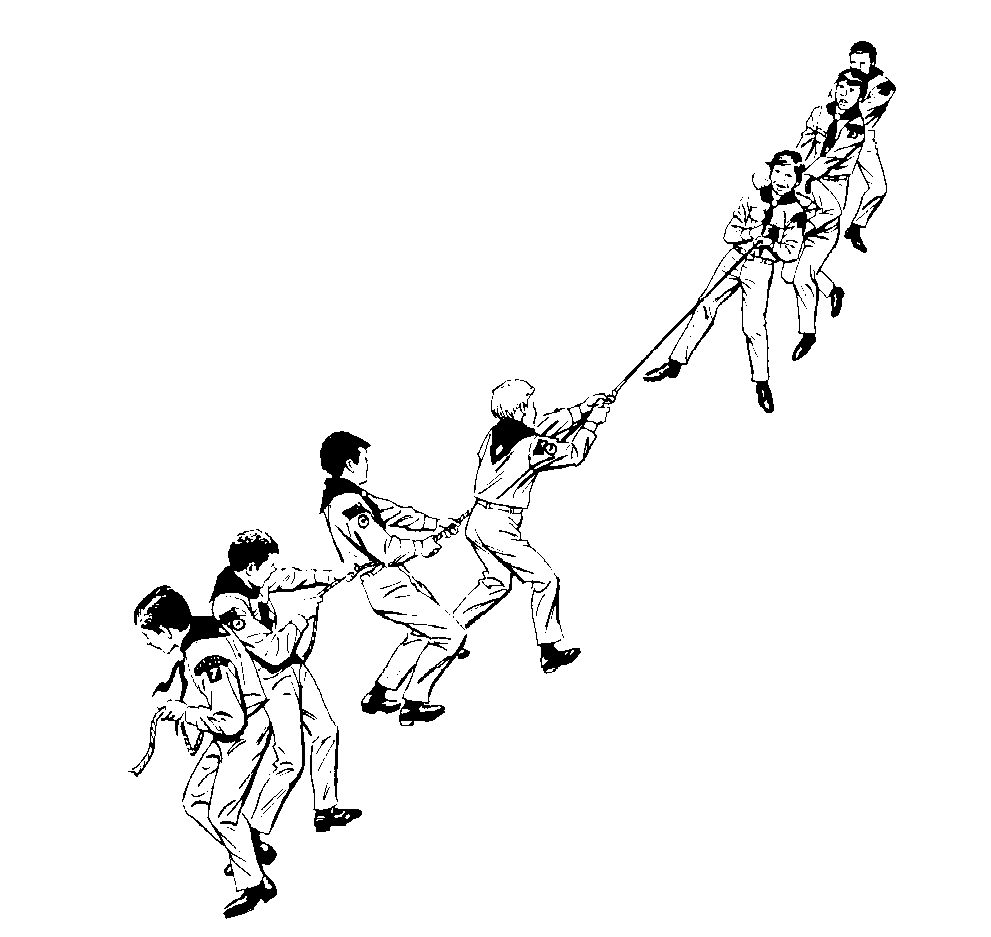 While you may not be able to see this for a few minutes (it's CPU load is too high!), anyone who has been following the great String Theory Debate of 2006, via the action and reaction to the Smolin and Woit books, might want to check out UCSB Professor Joe Polchinski's review of them. This is a 'web-only' enhanced version, with some very candid and informative footnotes. Having read Smolin's book recently, I am trying to apply a more skeptical eye to string theories claims, and especially their media hype. But this is science, folks, and there ain't no science without arguing (and sometimes the down-and-dirty, ad hominem type, but that's not here -- you'll have to poke around Lubos Motl's blog and comments on other blogs for that!)
While you may not be able to see this for a few minutes (it's CPU load is too high!), anyone who has been following the great String Theory Debate of 2006, via the action and reaction to the Smolin and Woit books, might want to check out UCSB Professor Joe Polchinski's review of them. This is a 'web-only' enhanced version, with some very candid and informative footnotes. Having read Smolin's book recently, I am trying to apply a more skeptical eye to string theories claims, and especially their media hype. But this is science, folks, and there ain't no science without arguing (and sometimes the down-and-dirty, ad hominem type, but that's not here -- you'll have to poke around Lubos Motl's blog and comments on other blogs for that!)
Sunday, December 03, 2006
Wondering about Wonders (VOTE NOW)
 CNN posted an amusing series of articles last week on "Modern Wonders" of the world, taking stock of the great engineering feats of the last couple of decades. Near the bottom of the page, they give us the humble readers a chance to vote on our "choice", of which they give us seven possibilities. Now while it would have been more interesting for the readership to nominate their own, who can complain: CERN alone accounts for two of them -- the World Wide Web and the LHC itself -- and those are the two that have topped their informal poll on which is the "greatest wonder" of the seven.
CNN posted an amusing series of articles last week on "Modern Wonders" of the world, taking stock of the great engineering feats of the last couple of decades. Near the bottom of the page, they give us the humble readers a chance to vote on our "choice", of which they give us seven possibilities. Now while it would have been more interesting for the readership to nominate their own, who can complain: CERN alone accounts for two of them -- the World Wide Web and the LHC itself -- and those are the two that have topped their informal poll on which is the "greatest wonder" of the seven.It's gratifying that these two projects have been recognized by the public. Instead of just being a big bridge to admire, one of them spawned the largest "world mind" that anyone could have imagined, and the other will hopefully give that collective mind a few new things to rattle around in its collective brain for the next decade. Of course, I really hope the media avoids interesting non-sequiturs like this one in the future:
It is so powerful, it is capable of creating mini-black holes. The hope is that the collisions -- up to one billion per second -- will reproduce the conditions that were in existence immediately after the Big Bang some 10 billion years ago.Really, I appreciate the interest of news outlets like CNN, but would a tiny level of fact-checking hurt anyone?
(Thanks, Howard)
Wednesday, November 29, 2006
Polonium, for Sale?

Never has my career (nuclear physicist) seemed so...timely, as it does now, with this outrageous Litivinenko affair. But pity the poor guys at, yes, United Nuclear, legal salesmen of radioactive sources for the general public. Atomic experiments for boys, indeed.
Thursday, November 09, 2006
Discover String Theorist
 Interestingly, and flatteringly, I've been getting some emails directly from publishers and magazines promoting their products. I hope I have enough readers (but it's quality and not quantity, right?) to warrant this attention!
Interestingly, and flatteringly, I've been getting some emails directly from publishers and magazines promoting their products. I hope I have enough readers (but it's quality and not quantity, right?) to warrant this attention!Anyway, the people at Discover.com have alerted me to an online chat with Lisa Randall, today from 2-3pm. Have a look/listen/read if you can. She's been making serious waves on popular culture this last year.
Of course I've had her book on my to-read list for a year and haven't managed to read more than the acknowledgements. On the other hand, I have been reading Lee Smolin's new book, which is being branded as "anti-string theory", but I've been finding fascinating for many other reasons. Stay tuned for my blog review.
Monday, October 30, 2006
Building Supporting Research
Anyway, all of this is to express my appreciation to the DOE for funding a spanking-new addition to BNL architecture (a long neglected field of study): the Research Support Building. This lab is going to be around for quite a while yet, and it deserves structures that send out that message (the nanoscience building is next...).
Only one thing missing: the smell of freshly-brewed coffee in the atrium. Hopefully more on that some other time.
Wednesday, October 25, 2006
Nashville
Monday, October 23, 2006
Boy in the Bubble
 Yow, way behind on blogging again. Not that I haven't been up to anything, but it would take me all day just to recap the last couple of weeks. Suffice it to say that I've done a few things I've never done before: bike 60 miles, get engaged, and go to Nashville, where I am now. I can tell you which one was my favorite, and staying here in a bubble is not one of them! I am attending the meeting of the "Topical Group on Hadron Physics", where I gave a talk yesterday, but I'm heading home tomorrow to get back to my real life. It's hard to explain the effect of living inside a huge (63 acre) hotel where you can walk for 15-20 minutes (which I often had to just to change sessions) without ever going outside. It's apparently the closest to a Vegas hotel you can get without actually hitting the casinos (I've never been to Vegas so I have to take the world's word for this).
Yow, way behind on blogging again. Not that I haven't been up to anything, but it would take me all day just to recap the last couple of weeks. Suffice it to say that I've done a few things I've never done before: bike 60 miles, get engaged, and go to Nashville, where I am now. I can tell you which one was my favorite, and staying here in a bubble is not one of them! I am attending the meeting of the "Topical Group on Hadron Physics", where I gave a talk yesterday, but I'm heading home tomorrow to get back to my real life. It's hard to explain the effect of living inside a huge (63 acre) hotel where you can walk for 15-20 minutes (which I often had to just to change sessions) without ever going outside. It's apparently the closest to a Vegas hotel you can get without actually hitting the casinos (I've never been to Vegas so I have to take the world's word for this).Anyway, Nashville itself is pretty neat: the honkytonks really look and act like I hoped. Stay tuned for photos.
Friday, October 13, 2006
Google does Units
 Speaking of Google, a colleague pointed out that the search engine knew what a GeV was -- in joules. I wanted to check if it knew how to combine units, and do a bit of quantum mechanics at the same time: check. Freshman physics will never be the same, especially if they can bring their EDGE-enabled cellphones.
Speaking of Google, a colleague pointed out that the search engine knew what a GeV was -- in joules. I wanted to check if it knew how to combine units, and do a bit of quantum mechanics at the same time: check. Freshman physics will never be the same, especially if they can bring their EDGE-enabled cellphones.
Pixelization of the Landscape
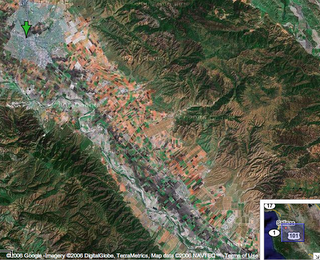 Now that experts have discovered where the deadly E Coli comes from, I wanted to get the big picture. And that comes from Google Maps of course. What blew my mind about this satellite view of the Salinas valley was the stark contrast betwen the green mountainous regions to the northeast and southwest, and the complete parcelling out of the fertile land in the valley. I first thought the satellite image had been tampered with until it became obvious that the pixelization was man-made, on gargantuan scales. Nothing incredibly deep here, but the contrast surprised me.
Now that experts have discovered where the deadly E Coli comes from, I wanted to get the big picture. And that comes from Google Maps of course. What blew my mind about this satellite view of the Salinas valley was the stark contrast betwen the green mountainous regions to the northeast and southwest, and the complete parcelling out of the fertile land in the valley. I first thought the satellite image had been tampered with until it became obvious that the pixelization was man-made, on gargantuan scales. Nothing incredibly deep here, but the contrast surprised me.
Wednesday, October 04, 2006
Accelerator in Your Pocket?
 And speaking of GeV, here's a somewhat old article pointed out in Slashdot yesterday: "From Zero to a Billion Electron Volts in 3.3 Centimeters: Highest Energies Yet From Laser-Wakefield Acceleration".
And speaking of GeV, here's a somewhat old article pointed out in Slashdot yesterday: "From Zero to a Billion Electron Volts in 3.3 Centimeters: Highest Energies Yet From Laser-Wakefield Acceleration". Impressive as this is, "It's the tip of the iceberg," says Leemans. "We are already working on injection" -- inserting an already energetic beam into an accelerating cavity -- "and staging," the handoff of an energetic beam from one capillary to the next and subsequently to others, until very high energy beams are achieved. "Brookhaven physicist Bill Weng has remarked that achieving staging in a laser wakefield accelerator would validate 25 years of DOE investment in this field."Holy crap.
Leemans's group and their collaborators look forward to the challenge with confidence. "In DOE's Office of Science, the High Energy Physics office has asked us to look into what it would take to go to 10GeV. We believe we can do that with an accelerator less than a meter long -- although we'll probably need 30 meters' worth of laser path."
How Jets were Born
 Amidst this interesting article in the science times yesterday on the issues faced by women in science, and physics more specifically, it was pointed out that Gail Hanson of UC Riverside discovered "quark jets". I have to admit that, even after being in my field for 15 years, I had never heard of anyone credited with the discovery of jets. Rather, I had always understood the "discovery" of jets to be the gradual acceptance of the phenomenon by high energy physicsts as the energy increased.
Amidst this interesting article in the science times yesterday on the issues faced by women in science, and physics more specifically, it was pointed out that Gail Hanson of UC Riverside discovered "quark jets". I have to admit that, even after being in my field for 15 years, I had never heard of anyone credited with the discovery of jets. Rather, I had always understood the "discovery" of jets to be the gradual acceptance of the phenomenon by high energy physicsts as the energy increased.Of course, I was wrong. And I'm probably the last to realize this, since she's already won a Panofsky prize for this work.
Here's the link to the article on "Evidence for Jet Structure in Hadron Production by e+e- Annihilation" from Gail Hanson's website. Not only is this the first time anyone established the "jettiness" of hadrons emerging from the annihilations of electrons and positrons at "high energies" (6-7 GeV in this case), but there's actually a "first author" on this paper (Hanson herself), something which never happens anymore in high energy or nuclear physics anymore!
Tuesday, October 03, 2006
Ready for the Prize?
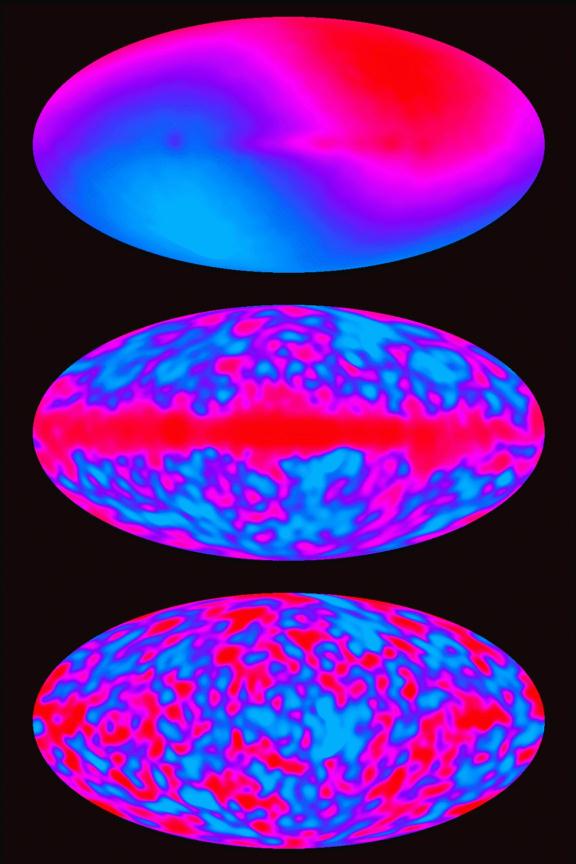 You can feel it in the air in early Autumn: the imminence of the Physics Nobel Prize announcement. I had just arrived at CERN this morning (after a major move from upper Manhattan to Chelsea...long story) when the announcement appeared. The COBE guys have finally gotten their due, and I suppose the huge success of the WMAP program, which is nominally "better", justified the lasting influence of the earlier measurements. However while year-after-year, I am consistently surprised by the choices (both in their content and timing), this year's lucky pair sounded somewhat prepared:
You can feel it in the air in early Autumn: the imminence of the Physics Nobel Prize announcement. I had just arrived at CERN this morning (after a major move from upper Manhattan to Chelsea...long story) when the announcement appeared. The COBE guys have finally gotten their due, and I suppose the huge success of the WMAP program, which is nominally "better", justified the lasting influence of the earlier measurements. However while year-after-year, I am consistently surprised by the choices (both in their content and timing), this year's lucky pair sounded somewhat prepared:Smoot: ''The discovery was sort of fabulous. It was an incredible milestone. Now this is a great honor and recognition. It's amazing,'' he said.
Mather: "I can't say I was completely surprised, because people have said we should be awarded, but this is just such a rare and special honor,'' Mather said in a telephone interview with the Nobel committee.
Thursday, September 28, 2006
Artifact
 Look what I dug up. I didn't realize that I was audio blogging back in the early 90's. Ok ok, I found this here, via Gizmodo via Boing Boing.
Look what I dug up. I didn't realize that I was audio blogging back in the early 90's. Ok ok, I found this here, via Gizmodo via Boing Boing.
Saturday, September 23, 2006
Quarks Swim Free
 Not sure how I missed this, but Elliot Sharp has a piece floating around town these days that I really should check out: "Quarks Swim Free":
Not sure how I missed this, but Elliot Sharp has a piece floating around town these days that I really should check out: "Quarks Swim Free":Quarks Swim Free is E#'s latest algorithmic piece for Orchestra Carbon. For 11 or more musicians and based on prime numbers, Quarks Swim Free creates a dense primordial soup filled with high-energy collisions, gnashing grooves, and warped melodies. Quarks Swim Free premiered at the Venice Biennale in 2003. This performance will be captured by noted documentarian Bert Shapiro for his film on E#'s work.Sounds neat, but I was intrigued where the title came from. Best I could come up with was Kenneth Chang's NYT piece (archived by Brookhaven here):
For this concert the ensemble includes Kinan Azmeh, Curtis Fowlkes, Rachel Golub, Brad Jones, Ron Lawrence, Jenny Lin, Chris McIntyre, Rudresh Mahanthappa, Kevin Ray, Danny Tunick, Alex Waterman and more
An atomic nucleus consists of protons and neutrons, which, in turn, consist of smaller particles, quarks. Quarks are held together by still another type of particle, gluons. In ordinary matter, it is impossible to pull out an individual quark or gluon.I saw Sharp play at a benefit last year, accompanying a Jenn Reeves film (thanx Jen!), and I definitely would have swung by last night (if one can swing by Carroll Gardens from the Upper West Side...), but it's Rosh Hashanah folks and Kate and I had a service to attend. Happy new years everyone!
But with hot temperatures and high pressures, physicists theorize, the gluon bindings loosen, and the quarks can swim free, melting protons and neutrons into a new state of matter, a quark-gluon plasma.
Thursday, September 21, 2006
Blow-Up
 Uh-oh, trouble in cosmologyland: Type Ia supernovae, the objects responsible for the post-1998 consensus that the universe is not just expanding, but accelerating, aren't such standard candles after all:
Uh-oh, trouble in cosmologyland: Type Ia supernovae, the objects responsible for the post-1998 consensus that the universe is not just expanding, but accelerating, aren't such standard candles after all:Now, astronomers led by Andrew Howell of the University of Toronto in Canada have found a type Ia supernova that is 2.2 times as bright as others of its class. Called SNLS-03D3bb, it lies about 3 billion light years away, a distance that was independently verified by studying the light spectrum of its host galaxy.As a student, I found it amazing that you could use brightness to measure distance. One always suspects that it's harder than it looks, but it's quite impressive that they have sufficient precision to detect outliers. Unfortunately, once everyone trying to image the dynamics of a younger universe gets on board, they're probably going to have a fun time agreeing on just who the "rogues" really are.
That brightness, along with other clues from the supernova's spectrum, suggests the white dwarf exploded with 2.1 solar masses of material – significantly above the Chandrasekhar mass. "It wasn't a little bit over – it was way over," Howell told New Scientist. "We're forced to say it's not a measurement error."
These young galaxies are found more often in the early universe, which corresponds to greater distances from Earth. "This might actually improve our precision in future studies if we identify this little subset of supernovae," says Howell.In my kind of physics, we sometimes call such things "pentaquarks". Ouch.
(Thanks to slashdot, apologies to Brian de Palma for post title...)
Monday, September 11, 2006
The Rising
The dam itself is a beautiful object in itself, massive beyond words. All of this, plus candids of Hillary Clinton, Chuck Schumer, and a Bruce Springsteen tribute band, here in my Flickr set.
Friday, September 08, 2006
The Chelsea Particle Zoo
 As one of the seemingly-few unofficial nuclear physicists about town, I can't resist chiming in when the culture industry starts to wander into scientific territory. Kate and I cut out of work a little early yesterday to check out the endless array of Chelsea art openings. I wasn't expecting much (not following the art scene too closely, I admit) but I wasn't expecting The Particle Zoo at the Mike Weiss Gallery.
As one of the seemingly-few unofficial nuclear physicists about town, I can't resist chiming in when the culture industry starts to wander into scientific territory. Kate and I cut out of work a little early yesterday to check out the endless array of Chelsea art openings. I wasn't expecting much (not following the art scene too closely, I admit) but I wasn't expecting The Particle Zoo at the Mike Weiss Gallery.Don't get me wrong, there is enormous potential in mining scientific concepts and images. Nature throws us many things we could never have imagined until we actually look (with eyes or detectors or telescopes or models, etc.). That said, rainbows and glassy shapes don't really do it for me.
Monday, September 04, 2006
Follow the Bouncing Ball
Clearly I didn't get to see Agassi's final game, but given the sold-out General Admission tickets I'm glad I got to see anything at all. Then again, who can complain about seeing greats such as Safin and Davenport without too much fuss? I even learned how to run my camera (Panasonic FZ10 -- beautiful machine, that) in "sports mode" and capture wild serve poses that I would never notice with just my eyes. There's a lot more richness to the game than just the elastics and ballistics of balls hitting rackets.
Wednesday, August 30, 2006
Melvin Schwartz Dies at 73
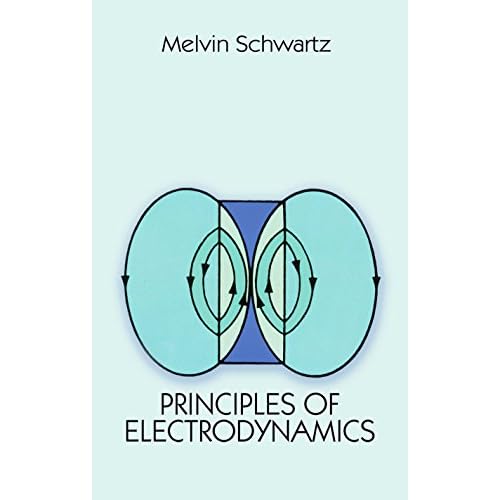 Terrible day, the world losing both Naguib Mahfouz and Melvin Schwartz. Schwartz was many things, a professor at Columbia, Nobel-prize winner in 1988 for the discovery of the muon neutrino, and a major figure in the history of Brookhaven. He was both a scientist there (i.e. the neutrino work) as well as an administrator (overseeing the RHIC project in its early stages!).
Terrible day, the world losing both Naguib Mahfouz and Melvin Schwartz. Schwartz was many things, a professor at Columbia, Nobel-prize winner in 1988 for the discovery of the muon neutrino, and a major figure in the history of Brookhaven. He was both a scientist there (i.e. the neutrino work) as well as an administrator (overseeing the RHIC project in its early stages!). Just a point left out of the obituaries: I never met him (he had left the field again by the time I got my PhD), but I always enjoyed his book on electrodynamics. It was one of the more elegant descriptions of the physics and mathematics that I had seen up to that time (1991). And it was cheap -- god bless Dover.
Tuesday, August 29, 2006
Wired, Tired
 When did Wired magazine become merely glib?
When did Wired magazine become merely glib?Despite the demagoguery (and apparent laziness) of those who keep making these kind of claims (i.e. they haven't read anything about the subject since 1999 *before* the machine turned on, or they only read people who have written about it since, who themselves have been asleep since last century...), RHIC has produced hundreds of interesting papers, many new scientists, and several really fascinating results about high density matter. And no black holes.
(Thanks Rick!)
But if you check the next page, then things are more like it. In the "Wired, Tired, Expired" list for the week: "Wired: scientist blogs". Still can't say Wired is, well, required, but my vanity can't keep from giving it a few points.
Tuesday, August 22, 2006
Who's Gonna Live Forever?


Not to overdo NYTimes mining, but I'm still trying to figure this one out. Do the best of us truly become fame-obsessed, or run for the hills when the pressure gets too great?
Einstein, Mao,and Me
 How can someone resist procrastinating when stumbling on an article like this? Dennis Overbye's profile of Xu Liangying, the foremost translator of Einstein's works in China, and a communist revolutionary turned dissident. From humble beginnings:
How can someone resist procrastinating when stumbling on an article like this? Dennis Overbye's profile of Xu Liangying, the foremost translator of Einstein's works in China, and a communist revolutionary turned dissident. From humble beginnings:
The love affair between Dr. Xu, who was born in Linhai, Zhejiang, in 1920, and Einstein began when Dr. Xu was in secondary school and read a collection of Einstein’s essays called “The World as I See It.” The book had as much politics as science. In one passage that the young Xu underlined, Einstein wrote: “The state is made for man, not man for the state. I regard the chief duty of the state to protect the individual and give him the opportunity to develop into a creative personality.”
Dr. Xu said, “I wanted to be such a person.”
Einstein's outlook on intellectual freedom developed into a source of political philosophy that got Xu into more trouble than not. Definitely worth a few wasted minutes at work.
Monday, August 21, 2006
A Matter Darkly
 Go freaking figure, just a day after ranting on about RHIC physics to a whole group of friends who trekked out to BNL from NYC, those damn astronomers have got to get some cheap media attention by doing something easy: like finding dark matter. What I find somehow pleasing, though, is how conceptually familiar it all feels. Hereby begins a novice's description
Go freaking figure, just a day after ranting on about RHIC physics to a whole group of friends who trekked out to BNL from NYC, those damn astronomers have got to get some cheap media attention by doing something easy: like finding dark matter. What I find somehow pleasing, though, is how conceptually familiar it all feels. Hereby begins a novice's descriptionThe image shows a collision of two galaxy clusters, but imaged in three different ways. The optical image shows flashes of white galaxies, something we are used to seeing through telescopes. The pink shows an image of the distribution of hot gas surrounding the cluster, imaged by X-ray astronomy (i.e. by looking at the photons emitted by the gas), which seems to have taken on an oddly "Mach Cone" shape, if I may add. Finally the bluish clumps are the distribution of mass, as imaged by the distorted views of the galaxies behind (i.e. gravitational lensing).
The rub lies in the way the pink and the blue have separated. The general view is that the gas has slowed down as the clusters passed through each other, while the dark matter has continued moving on. But if the gas was somehow the more massive part of the system, one would have also found the mass there as well.
The familiar part is that my colleagues and I have been pondering what happens when clumps of things we like, strongly-interacting nucleons (i.e. nuclei), pass through each other at high speed. We also try and "image" the space time story, but of course using different tools. We can't see spatial distributions directly, but we can infer them from the final velocities. Of course, they can't repeat their collisions, while we do so thousands of times per second. And we're all using theories, like hydrodynamics, which are amazingly applicable at extremely microscopic and extremely macroscopic scales.
Friday, August 18, 2006
School of Rock, Gnarls-style
Tuesday, May 23, 2006
Remain in Light
 It's spring, and I use almost any excuse to post songs I like (which I only seem to do when I have too much time on my hands, as was the case this weekend with my girlfriend out of town). This one seems to have arisen out of a recent Talking Heads re-obsession, mixed with working to Fela Kuti albums (on iTunes, cheap) as background music. Have a listen.
It's spring, and I use almost any excuse to post songs I like (which I only seem to do when I have too much time on my hands, as was the case this weekend with my girlfriend out of town). This one seems to have arisen out of a recent Talking Heads re-obsession, mixed with working to Fela Kuti albums (on iTunes, cheap) as background music. Have a listen.
Sunday, May 21, 2006
Spinning Round (or Square or Hexagonal...)
 From Slashdot, here's this unreal article in Nature.
From Slashdot, here's this unreal article in Nature.Tomas Bohr and colleagues made plexiglass buckets, 13 and 20 centimetres across, with metal bottoms that could be rotated at high speed by a motor. They filled the bucket with water and spun the bottom to whip up the liquid into a whirlpool that rose up the sides of the container.I mean, symmetry breaking is one thing, but where do pentagons come from? Why do things "quantize" in this way, when there's nothing obvoiusly "quantal"about the problem?
This set-up is very similar to the rotating bucket that Isaac Newton used in the seventeenth century to investigate centrifugal forces.
The researchers found that once the plate was spinning so fast that the water span out to the sides, creating a hole of air in the middle, the dry patch wasn't circular as might be expected. Instead it evolved, as the bucket's spin sped up, from an ellipse to a three-sided star, to a square, a pentagon, and, at the highest speeds investigated, a hexagon.
Saturday, May 20, 2006
No, Steve, *you* the man
That said, something about this opening felt important (and not just to justify two hours waiting in line just to see a store.) This is a computer store, opening up (and staying open 24/7/365) at the gateway to the shopping on 5th Avenue, but right on Central Park. But it's also an architectural gem, a focal point for technology and content, California and New York, young and old, and so on. And it's a far cry from the tiny shop in Lincoln Park in Chicago in 1979 where I saw my first Apple ][, but it feels just as special. There are reasons people (like me) are so impressed by Jobs and his good works, and this is an important one for me.
Thursday, May 18, 2006
Boulder Workshop 2006
Monday, May 15, 2006
Big Bang of the Day
Big (Glass and Chrome) Bang
 Damn, 3quarksdaily beat me to this one, but I just wanted to show a photo and say a few words about Josiah McElheny's show at the Andrea Rosen Gallery in Chelsea, which I saw on Saturday. My friend Ofer pointed me to an article about this in the NY Times last weekend (now hidden behind the walls of Times Select), but nothing in there prepared me for how amazing this was. "An End To Modernity" is an homage to both the chandeliers at the Met Opera house in Lincoln Center and the introduction of the Big Bang theory, both in 1965. One sees the emanation of "lines" from an occluded "core" (indicating the moment of recombination, when the universe became opaque), and the development of those "lines" into clusters of galaxies of different shapes. Really excellent, and moving in its size, scope, and attention to detail (both of craftsmanship, and scientific).
Damn, 3quarksdaily beat me to this one, but I just wanted to show a photo and say a few words about Josiah McElheny's show at the Andrea Rosen Gallery in Chelsea, which I saw on Saturday. My friend Ofer pointed me to an article about this in the NY Times last weekend (now hidden behind the walls of Times Select), but nothing in there prepared me for how amazing this was. "An End To Modernity" is an homage to both the chandeliers at the Met Opera house in Lincoln Center and the introduction of the Big Bang theory, both in 1965. One sees the emanation of "lines" from an occluded "core" (indicating the moment of recombination, when the universe became opaque), and the development of those "lines" into clusters of galaxies of different shapes. Really excellent, and moving in its size, scope, and attention to detail (both of craftsmanship, and scientific). Of course, I see RHIC collisions everywhere, and this is no exception. I see hadron emission from an "initial state" which we have trouble understanding due to "hadronization" and the decay of those hadrons isotropically in their own rest frame. But maybe I see dead people too? If anyone is interested, I can explain more -- i think the analogy works pretty well (except RHIC collisions are definitely not globally isotropic, as many think the universe is and should be...). There are even points of light -- photons! -- in between the clusters of glass. Nice to have a model to simultaneously compare one's thinking on Big and Little Bangs.
Tuesday, May 02, 2006
Rock the Casbah
Monday, May 01, 2006
Springtime @ BNL
Sunday, April 30, 2006
Visions in Collisions, Hummingbirds, etc.
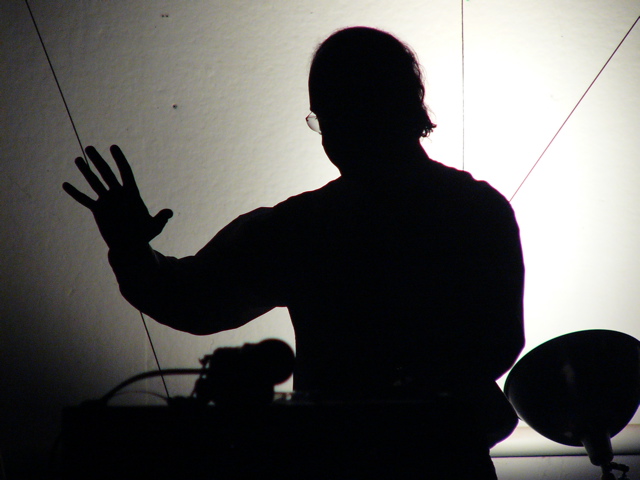 So last night I finally had my chance to teach "Physics for Filmmakers" and the results kind of look like this. The whole thing was a real 'hail mary', in that I came up with the title in mid-March before I had any idea, but eventually the actual content somehow nucleated around the title. I first tried to show how physicists image the fleeting traces of particles, which are not visible to the human eye, by means of various detector technologies. Lucky for me that even cursory Google searches yield troves of classic particle physics images. Then I tried to sketch out how we take these images of particles and "run the movie" backwards to understand the primordial event that yielded them. I tried to keep the tone breezy and the focus on the visuals (and make wisecracks whenever possible), and I hope it worked. I had a lot of fun giving the talk to this audience of filmmakers and friends and I think they had fun too. I even got a few questions during the wine & cigarette break (all the smokers took an unplanned exit when we had a few video problems at the start of my talk...).
So last night I finally had my chance to teach "Physics for Filmmakers" and the results kind of look like this. The whole thing was a real 'hail mary', in that I came up with the title in mid-March before I had any idea, but eventually the actual content somehow nucleated around the title. I first tried to show how physicists image the fleeting traces of particles, which are not visible to the human eye, by means of various detector technologies. Lucky for me that even cursory Google searches yield troves of classic particle physics images. Then I tried to sketch out how we take these images of particles and "run the movie" backwards to understand the primordial event that yielded them. I tried to keep the tone breezy and the focus on the visuals (and make wisecracks whenever possible), and I hope it worked. I had a lot of fun giving the talk to this audience of filmmakers and friends and I think they had fun too. I even got a few questions during the wine & cigarette break (all the smokers took an unplanned exit when we had a few video problems at the start of my talk...).
Other highlights for me were:
- The Thereminvox performance by Anthony Jay Ptak (who turned out to have gone to high school just down the road from Brookhaven...)
- An unbelievable archival film of Edgerton's high speed stroboscopic films. Smoke, birds, snakes, insects - one always forgets the richness of physical and biological phenomena when one sees them at "human" speeds. 6000 frames a second can show a lot...
- Liquid crystals filmed by Jean Painleve
- Void Ratio by Ray Sweeten - the funniest oscilloscope tutorial I've ever seen. Should be a part of every freshman physics course, including the extended visual freakout in the second half.
- I also liked Jennifer's The Garden Dissolves into Air, a montage of images from the Brooklyn Botanical Garden processed through the "optical printer" (and a Macintosh, of course...)
A fun evening, all in all. You can find my slides here.
Monday, April 24, 2006
Live!
 Please don't take my silence as indications that I'm giving up. It's just been insanely busy, with trips to Chicago and Toronto, and various projects at work coming together asynchronously. And I got tenure. Tenure.
Please don't take my silence as indications that I'm giving up. It's just been insanely busy, with trips to Chicago and Toronto, and various projects at work coming together asynchronously. And I got tenure. Tenure.Anyway, one of the projects I've been working on has been a short public talk I'll be giving as part of the show "Aerodynamics of the Hovering Hummingbird: Science, Cinema, and Ways of Seeing". It's on Saturday, April 29, 8 pm at Millennium Film Workshop and is curated by Jennifer MacMillan and Bradley Eros. Please come and check it out -- I saw a previous evening Jennifer curated and it was really fun and interesting.
My talk is called "Visions in Collisions", and will be a few reflections on the ways particle and nuclear physicists see both particles, and the underlying dynamics that created them. Think of us as trying to reconstruct a whole movie when we only have access to the last few frames.
Friday, April 07, 2006
Like Steve
And when it comes to getting presentations (especially the visuals) right, it's hard to beat the instincts of Steve Jobs, co-founder of Apple (especially, as manifest in Keynote, Apple's homegrown presentation software). And now, you too can know the secrets of Steve Jobs, at least as divined Carmine Gallo in BusinessWeek. But here's the thing: while I am not interested in turning scientists into Powerpoint-wielding corporate drones, it surprises me how often scientists ignore common-sense when preparing and delivering talks. I know I'd enjoy conferences so much more if people could just be a bit more like Steve.
(from TUAW)
Wednesday, April 05, 2006
RHIC on the Radio
 Now here was a surprise. I was doing my occasional wanderings through that Internets thing trying to see if there was anything on RHIC out there in the media that I had missed. And lo, while I was poking around the WNYC website, I noticed a link to "Radiolab", a show I've heard advertised but never heard (a problem now solved for me with radioSHARK...), clicked on it, and found myself drawn to this quote:
Now here was a surprise. I was doing my occasional wanderings through that Internets thing trying to see if there was anything on RHIC out there in the media that I had missed. And lo, while I was poking around the WNYC website, I noticed a link to "Radiolab", a show I've heard advertised but never heard (a problem now solved for me with radioSHARK...), clicked on it, and found myself drawn to this quote:A Simpler Time"45 feet from the beginning of time"? Holy incompatible units, Batman (but maybe they just suppressed the "c", like pro physicists do?). Anyway, after a bit of fiddling around to find a link to the show which actually worked, I got to hear about RHIC on the radio.
Have you ever wished you could time travel, like in the movies? Artist Terry Wilcox asks us to imagine 1,594 years into the future, when his sculptural clock will chime. A particle accelerator jockey at Brookhaven National Laboratory takes us 45 feet away from the beginning of time. And Swedish producer Marcus Lindeen introduces us to David McDermott, an artist who devotes his life to ignoring the present.
The piece was unfortunately introduced by means of the aforementioned Terry Wilcox, who was worried about those "scientists at Stony Brook making a universe". OK, he missed hitting Brookhaven by about a 45 minute drive, and was attributing a scientific goal I haven't heard much of since Benford's sci-fi novel Cosm. But there we were, with Robert Krulwich interviewing one of my RHIC colleagues, Todd Satogata, about the collider. OK so a few details were botched (like RHIC colliding nuclei to study the properties of the early universe, and not protons), and some of the verbal imagery and sound effects made it sound like we were doing some serious universe creating around these parts. Still, overall I found the piece to have a surprisingly light touch and conveyed a lot of the enthusiasm we feel about our physics. Let's do some more fact-checking next time, Radiolab!
Wednesday, March 15, 2006
Awakening
 Gee has it really been 2 weeks since my last post? I suppose it has, but it's not like I had any time to think about it. Since Geneva, I definitely lost a week both to jet lag and talk writing. Then the next week was probably a trifecta for me: a visit to Ohio State University where I gave both a Departmental Colloquium and a Nuclear Physics Seminar, followed a day later by a PHENIX talk at a workshop at BNL on running RHIC at very low energies. Three talks in three days: makes me drowsy just to remind myself.
Gee has it really been 2 weeks since my last post? I suppose it has, but it's not like I had any time to think about it. Since Geneva, I definitely lost a week both to jet lag and talk writing. Then the next week was probably a trifecta for me: a visit to Ohio State University where I gave both a Departmental Colloquium and a Nuclear Physics Seminar, followed a day later by a PHENIX talk at a workshop at BNL on running RHIC at very low energies. Three talks in three days: makes me drowsy just to remind myself.The visit to OSU was incredibly interesting, as they have quite a group of nuclear physicists, both experimental and theoretical, who kept me busy for two solid work days, leaving me not as much time to prepare for the workshop as I would have preferred! Then again, I didn't prefer to have two planes, on two different airlines, malfunction on the ground in Ohio just as I was trying to board them. While the second one turned out to require only a quick repair, my return to my apartment in NYC was spoiled by a complete absence of water, due to a broken main on Broadway. Fortunately, I had a backup plan, allowing me to attend the low-E workshop with a minimum of unnecessary odor!
Since then, I've been recovering a bit, seeing friends a bit, seeing art a bit (like this dreamy video installation at Scope New York), seeing Garrison Keillor with the NY Philharmonic a bit (thanks Terry and Rachel!), and trying to wake up for a new round of ATLAS work. But speaking of waking up, I was utterly blown away by the reports that Ambien, the enormously popular sleeping pill, seems to trigger sleep-eating in many people, who gorge themselves at night, and wake up remembering nothing, although they have food in their mouths. Doesn't anyone sleep anymore? Turns out that lots of people think they don't, as they lie awake for an hour or so in the middle of the night (I know I do this!), but some people think that this is the most natural sleep pattern of all. Go figure.
Wednesday, March 01, 2006
John Cale in Geneva
Here's a shot of a John Cale show we caught at L'Usine the night before heading back to the US. Most notable was how excellent the show was, bursting with ideas and energy (incredible especially for a guy the same age as my parents -- I hope I age as gracefully). A close second was the absolute ban on smoking, requested by Cale himself. One of the bouncers mentioned that Cale would flat-out stop if he smelled smoke. That's another serious change from 10 years ago.
Tuesday, February 28, 2006
Robot Wars, Geneva
Tuesday, February 21, 2006
ATLAS & Me
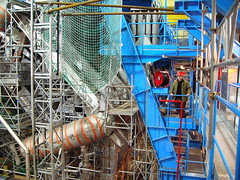 These days, it's not a trip to CERN without a tour in the ATLAS pit. My colleague Pavel snapped this photo of me standing on the scaffolding next to a tiny fraction of the ATLAS detector, which is currently under feverish construction in advance of the LHC start-up, still planned for end-2007.
These days, it's not a trip to CERN without a tour in the ATLAS pit. My colleague Pavel snapped this photo of me standing on the scaffolding next to a tiny fraction of the ATLAS detector, which is currently under feverish construction in advance of the LHC start-up, still planned for end-2007.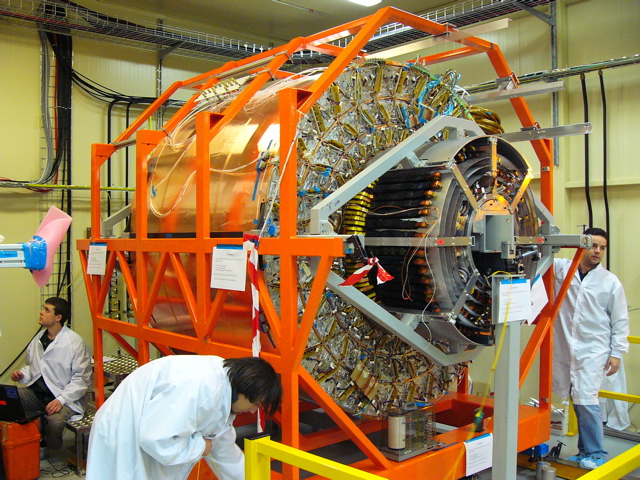 Needless to say, this thing is big. BIG. But what I still find fascinating is that while the muon system is enormous, and the calorimeters are huge, the "inner detector" which tracks particles in a profoundly complicated silicon and straw-tube detector is much more human-sized. My old colleague Heinz took me to their assembly room where they were surveying the recently-assembled "barrel". Much smaller, but a sublime piece of work with the millions of channels we will be using to study nucleus-nucleus collisions at the LHC.
Needless to say, this thing is big. BIG. But what I still find fascinating is that while the muon system is enormous, and the calorimeters are huge, the "inner detector" which tracks particles in a profoundly complicated silicon and straw-tube detector is much more human-sized. My old colleague Heinz took me to their assembly room where they were surveying the recently-assembled "barrel". Much smaller, but a sublime piece of work with the millions of channels we will be using to study nucleus-nucleus collisions at the LHC.
Mont Blanc, Revealed
I should mention, however, that I have not seen Mont Blanc from the CERN site since my student days in the mid 90's. It's usually been cloudy during my short visits here. The only way to really guarantee a good view is to head southeast by car. Give me a few days...
Friday, February 17, 2006
Who's the Scientist?

 This is the greatest thing I've seen in a while. A group of 7th graders visited Fermilab and made before-and-after descriptions and drawings of their image of scientists.
This is the greatest thing I've seen in a while. A group of 7th graders visited Fermilab and made before-and-after descriptions and drawings of their image of scientists.This is real progress, folks.
(Thanks, Betsy!)
Wednesday, February 15, 2006
Richard and Me
 This has been in the works quite a while, but is only now reaching the web. In October, I did an interview with Carolyn Weaver of Voice of America TV about RHIC, it's science, and the controversies surrounding the various "doomsday" scenarios proposed in the 80's and 90's. It's now posted on the VOA website.
This has been in the works quite a while, but is only now reaching the web. In October, I did an interview with Carolyn Weaver of Voice of America TV about RHIC, it's science, and the controversies surrounding the various "doomsday" scenarios proposed in the 80's and 90's. It's now posted on the VOA website.What I hadn't realized when I agreed to give this interview was that Weaver had already spoken to Richard Posner, the eminent federal judge. Posner wrote a book in 2004, "Catastrophe: Risk and Response", which discusses the risks of RHIC, among other disasters, and how we are currently not dealing with various eventualities. And here in the final product (shown to the right), I find myself superimposed on Posner, if only for a brief instant. How many of my lawyer friends can say that?
I've discussed Posner and other critics various times in my previous blog, and I maintain that I find their arguments still less than compelling in their particulars. But I never imagined I'd get a chance to say so in public. I still believe that while we should take risks seriously, and in general scientists should be held accountable for the risks they take, and discuss them openly. However, we must constantly be updating the level of risk based on incoming information. Posner (and Rees, for that matter) are basing everything on several papers written in 1999 and before, well before the RHIC data came in. Since that time, we have found that the matter we create at RHIC essentially blows apart as soon as it is made. And more importantly, this matter is not baryon rich, as it was at the AGS. This suggests to me that we're even less likely to make stable strange matter than ever before. That said, I should not be construed to be a real expert on this subject. But that said, no expert I know has suggested that the risk level has increased. There have even been searches for strangelets at RHIC (in the baryon-rich forward region) which have (as always) come up empty!
So until my colleagues A) actually isolate even a hint of a strangelet signal, and B) start to believe (based on experimental data) that RHIC is really a better enviroment for their production than previous facilities (which have established stringent upper limits), I think it's premature to start any serious discussions of the risk of RHIC to humanity as a whole. But I'm sure someone out there already disagrees with me.
Friday, February 10, 2006
Budget Watch, contd., and the Future
The AAAS released an analysis of the budget here, with a choice quote:
The Department of Energy (DOE) would enjoy substantial increases for its energy and science R&D portfolios in 2007, an unusual turn of events for a department that has mostly seen flat budgets in recent years (see Figure 6). The DOE Office of Science (OS) would emerge as the clear winner in the 2007 budget with a 14 percent increase to $3.8 billion for its R&D portfolio centered around the physical sciences. The largest OS programs would all receive increases of 8 percent or more, including a dramatic 24 percent boost for Nuclear Physics after a decade of stagnant funding, a 36 percent increase for computing research, a 25 percent increase for Basic Energy Sciences centered around several large-scale facilities, and a 31 percent increase for the core life sciences research portfolio. Although these increases would help BES, computing research, and nuclear physics reach new highs, high-energy physics, fusion, and biological and environmental research would remain below previous years’ funding levels because of years of eroding budgets.What a rollercoaster, from the World Year of Physics presenting us with the worst budget in a while, with many gloom-and-doom predictions for the future, to an enormous "bounce" (hope not a "dead-cat" bounce...) and a rosy outlook. But people should keep in mind that a 24% increase relative to 2006 doesn't translate into a huge increase if one averages over the last few years: it's only 15% above the 2005 budget, and inflation depreciates all funding by 3-4% a year, so it's really equivalent to a real 8% increase -- not peanuts to be sure, but it certainly does not sound as whopping as 24%!
This was echoed today by a short presentation by Directory Chaudhari presenting how the budget will directly affect BNL. He reported the robust RHIC budget, promising a 34 week run (not 30 as I mentioned previously), funding for RHIC II-related work (i.e. EBIS, the new ion source), R&D funding for NSLS II (which will be another major facility here, with QCDLab, if it gets sited here) and full funding of the Center for Functional Nanomaterials. All good news, but not nearly as striking as the projections for the lab's future, predicated on these increases. If all goes well, the general shrinking of personnel and near-constant funding levels over the last 5 years will reverse over the next 4-5 years, with the lab's funding increasing by 40% and employment increasing by over 10% over the next five years. Amazing prospects.
Wednesday, February 08, 2006
Justice for RHIC
 So after all of the struggles last year (remember the 65% solution?), things are certainly looking up this year. Newsday (and never the New York Times, it seems!) has a piece (and a photo of STAR, with my colleague Gene Van Buren in front!) which seems to have run twice in the last couple of days: "Proposal lets collider run a full schedule".
So after all of the struggles last year (remember the 65% solution?), things are certainly looking up this year. Newsday (and never the New York Times, it seems!) has a piece (and a photo of STAR, with my colleague Gene Van Buren in front!) which seems to have run twice in the last couple of days: "Proposal lets collider run a full schedule". The relativistic heavy ion collider received $121.5 million for 32 weeks of operation in fiscal 2005, but this year had its budget cut to $110 million. After a $13 million private donation, the collider is scheduled for 20 weeks of operation this year. The proposed 2007 budget includes $138 million for a full schedule of 30 weeks of operation.This sounds a little awkward, getting more money for less running, but people should realize that we have massive R&D needs, and major upgrades are underway, both for the big detectors (STAR and PHENIX) and for the accelerator (Uranium, anyone?)
But while I appreciate Newsday's interest quite a bit, I wish they would just stop saying this:
The collider is a superconductor that accelerates ions to nearly the speed of light, allowing scientists to explore the smallest known pieces of matterIt's an accelerator, not a superconductor! Yes, there are superconducting magnets everywhere, but ultimately the particles are accelerated in vacuum and just guided by the magnets. Yes it sounds niggly, but I don't think our material science friends would appreciate the confusion either.
Friday, February 03, 2006
Freedom from Justice?
 Just a short follow-up to that last post. I arrived for day 2 of Jury Duty at 10am, and essentially did nothing for the rest of the day, only to be fully discharged by 3:30pm, after a two hour lunch break. I was happy to do my duty, in principle, but it still makes me a bit sad that having an overly-developed sense of the objective, and thus a high standard for evidence, makes me a liability to the legal system as it is.
Just a short follow-up to that last post. I arrived for day 2 of Jury Duty at 10am, and essentially did nothing for the rest of the day, only to be fully discharged by 3:30pm, after a two hour lunch break. I was happy to do my duty, in principle, but it still makes me a bit sad that having an overly-developed sense of the objective, and thus a high standard for evidence, makes me a liability to the legal system as it is. So I guess the scales of justice aren't for me, despite the obvious point that they borrow their defining trope from the scientific method. Clearly, the whole concept of showing the scales of justice is to indicate an objective "measuring" the guilt of the defendant by recourse to brute facts. Go figure: maybe that's why lady justice is portrayed as blind?
Wednesday, February 01, 2006
Law and Physics
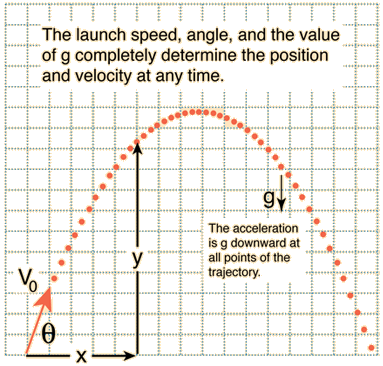 After the mayhem of last week, spending 8+ hours a day with ATLAS software, this week has taken on a whole new character: Jury Duty. After holding off the New York Supreme Court for a few months back in the autumn, I was finally compelled to drop by the courthouse this morning. I can't give much in the way of details, but I can report a few things that surprised me.
After the mayhem of last week, spending 8+ hours a day with ATLAS software, this week has taken on a whole new character: Jury Duty. After holding off the New York Supreme Court for a few months back in the autumn, I was finally compelled to drop by the courthouse this morning. I can't give much in the way of details, but I can report a few things that surprised me.Jury duty takes a lot less time than it used to: apparently it was two weeks, only a few years ago, but it's certainly never going to end after a day. Minimum is two days, and it's looking like typical cases can take days. Consider that next time you pick your next postponement date. The orientation is cheesy, the time lost from work is a little excessive, but after a while you really start to get into it. While it really looks like a hardship in the abstract, seeing a few details of how the legal system works is pretty neat. Heck, I'm a physicist: I like to know how things work, and the law is supposed to be a machine of sorts, right? Based on laws, just like physics, right?
Well maybe, but they certainly don't seem to value the scientific outlook. While I really can't say much about what went on the courtroom, I can say that I was in the first (large) group of people to be brought down to be considered for a jury. I can also say that I was in the first group of 12 to be considered out of the larger group. So for a few minutes I felt kind of proud of myself, that I could serve my civic duty. Then the questions began, as we cycled through our renditions of the "Voir Dire", a set of questions related to our ability to serve impartially on the jury. Have you ever been a victim of a crime? Do you know anyone in law enforcement? And so on. Most of us didn't set off any alarms in this way, as few people are so scarred by their experiences with courts or law enforcement that they can't consider a situation objectively.
Then they asked us what we did for a living and where we went to school. At first I didn't understand why, although it was fascinating to see the wide cross section of people they had selected, from a wide range of backgrounds and occupations. But a funny thing happened as soon as I said: "Physicist, PhD, MIT". "So you want to be an astronaut?" asked the New York Supreme Court Judge. That started to make me suspicious. Then the prosecuting DA asked: "Mr. Steinberg, scientists typically want objective means to verify facts. Do you think you will be able to believe testimony given by witnesses in the case?" I had to think about this one: "I would feel responsible to my duty to the court, but I really prefer to have some objective verification of facts I am given." I thought this seemed reasonable, to express a high standard for evidence. But the judge lit into me: "You scientists want all the answers! One has to be able to find a defendant guilty on the testimony of a single witness. It's not about the quantity, but the quality!" I realize that this has to be the case, for the system to convict anyone, but I've always been taught to verify everything, since even the smartest, most reliable, people can make mistakes in their perceptions or interpretations.
The defense attorney picked up on my response, however, in a way that made me very suspicious. After he asked me a few questions of what kind of physics I do ("nuclear physics? that's my favorite!" said the judge), he extended this issue of questioning testimony: "I hope all of you will be able to consider that a story given by a witness could be a lie." Always a possibility, but at that point I started to wonder if I was a goner. And after a short recess I was a goner, along with six others in my group, sent back to the pool of potential jurors. Although it wasn't the only reason to cut someone from a jury, the very training I was so proud of, the one that made me so sensitive to various issues in how we know what we know, made me essentially unqualified to serve in one of our most important civic institutions.
So while there are clearly laws of physics, there doesn't seem to be much room for physics in the law. Hasn't anyone seen Minority Report? Better luck tomorrow!
Monday, January 30, 2006
Time of Transition
 As usual, blogging slows down as life speeds up. And things have been quite intense recently, as attention shifts almost completely to my new projects. I'm finally making headway with my longer-term project for the PHENIX experiment (a little database, that should grow pretty big over time...) and we just finished an extensive week-long software workshop for ATLAS. This was really the big one for me, when I finally felt "over the hump" in terms of being able to actually use the ATLAS software, which is apparently quite powerful: but with great power comes great...complexity? Anyway, more later as I get my thoughts together (and finish a 15 page writeup of my lectures from Erice last summer, by Wednesday [gulp]).
As usual, blogging slows down as life speeds up. And things have been quite intense recently, as attention shifts almost completely to my new projects. I'm finally making headway with my longer-term project for the PHENIX experiment (a little database, that should grow pretty big over time...) and we just finished an extensive week-long software workshop for ATLAS. This was really the big one for me, when I finally felt "over the hump" in terms of being able to actually use the ATLAS software, which is apparently quite powerful: but with great power comes great...complexity? Anyway, more later as I get my thoughts together (and finish a 15 page writeup of my lectures from Erice last summer, by Wednesday [gulp]).

